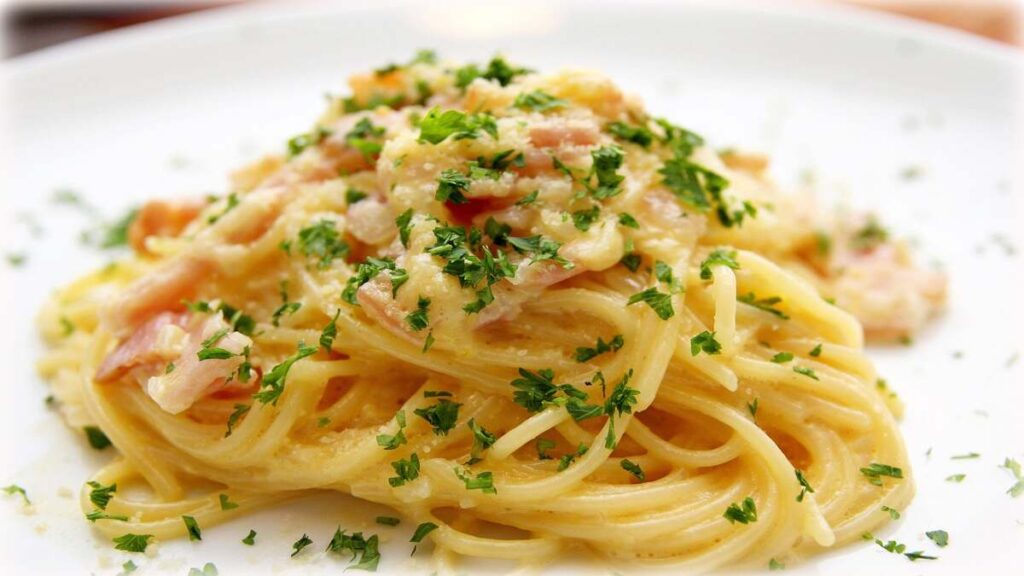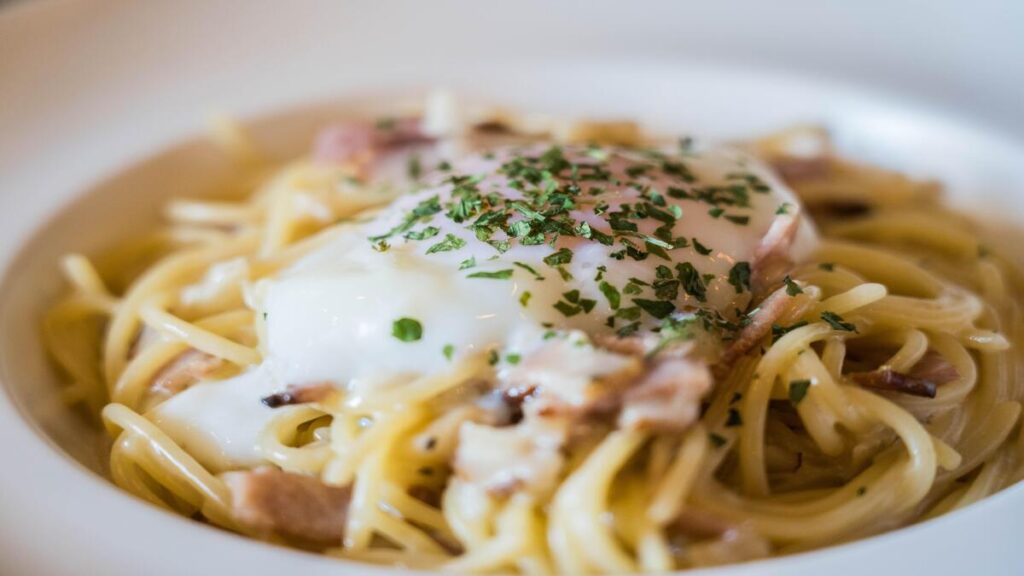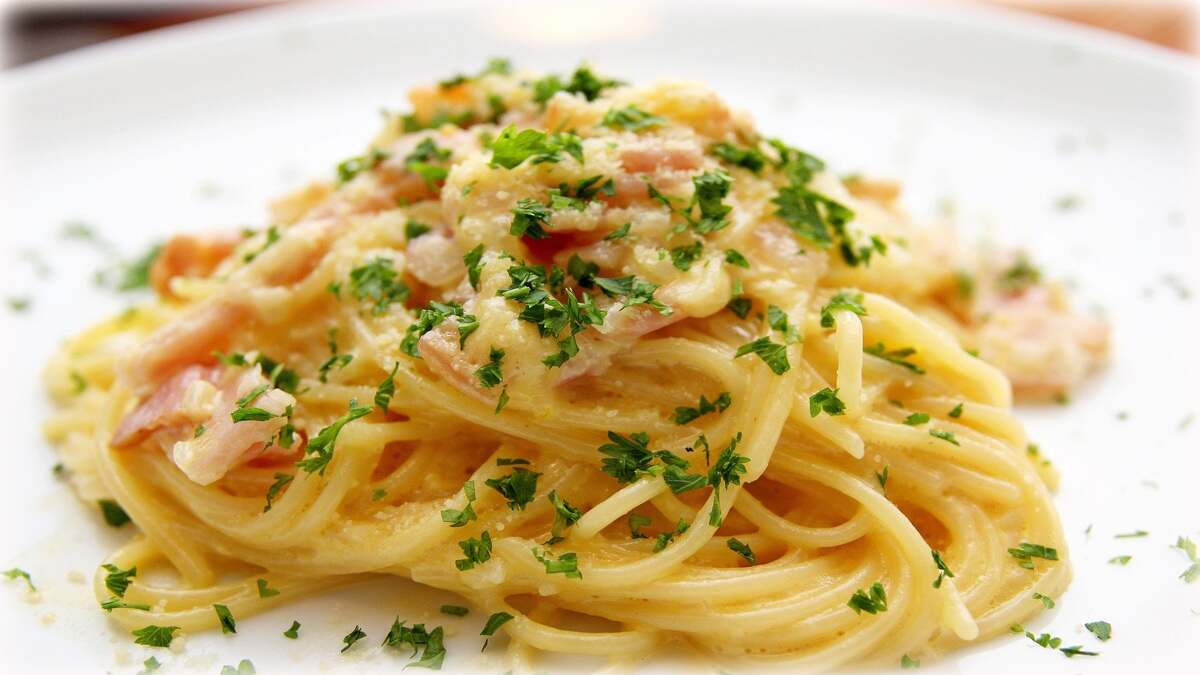Few dishes are as universally loved as Classic Carbonara Recipe a creamy, cheesy, and flavorful Italian pasta. With its velvety sauce, crispy pancetta, and al dente pasta, carbonara is a timeless classic that can transform any meal into a gourmet experience. Surprisingly simple to prepare, carbonara relies on quality ingredients and careful technique to create a dish that’s rich yet perfectly balanced. Whether it’s for a casual weeknight dinner or an elegant gathering, carbonara is always a winner.
What Is Classic Carbonara Recipe?
Classic Carbonara Recipe is a traditional Italian pasta dish made with eggs, Pecorino Romano cheese, pancetta, and black pepper. It’s known for its creamy sauce, which is created by emulsifying egg yolks and cheese with hot pasta water. Unlike cream-based pasta dishes, authentic carbonara relies solely on these simple ingredients to create its luxurious texture. It’s most commonly prepared with spaghetti, though other pasta varieties like fettuccine or rigatoni can also be used.
The Origin of Classic Carbonara Recipe
The exact origin of Classic Carbonara Recipe is a topic of debate, but it is believed to have originated in the Lazio region of Italy, particularly in Rome. The dish became popular during World War II when American soldiers stationed in Italy introduced bacon and eggs to local cooks. Over time, the dish evolved into the carbonara we know today, with Italian pancetta and Pecorino Romano cheese as key ingredients. It has since become a staple in Italian cuisine and a favorite worldwide.
Ingredients for Classic Carbonara Recipe
| Ingredient | Quantity |
| Spaghetti (or preferred pasta) | 400g (14 oz) |
| Pancetta (or guanciale) | 150g (5 oz) |
| Egg yolks | 4 large |
| Pecorino Romano cheese (grated) | 1 cup |
| Black pepper (freshly ground) | 1 tsp |
| Salt | To taste |
| Olive oil (optional) | 1 tbsp |

Equipment Needed
- Large pot for boiling pasta
- Skillet or frying pan
- Mixing bowl
- Whisk or fork
- Tongs or pasta fork
- Grater
- Measuring cups and spoons
Step-by-Step Preparation
1. Preparing the Pancetta
- Cut the pancetta or guanciale into small cubes or strips.
- Heat a large skillet over medium heat. Add the pancetta and cook until it’s golden and crispy, releasing its fat. Avoid overcooking to prevent it from becoming too crunchy.
- Remove the skillet from heat and set it aside, leaving the rendered fat in the pan for flavor.
2. Cooking the Pasta
- Bring a large pot of salted water to a boil. Add the spaghetti and cook until al dente, following the package instructions.
- Reserve about 1 cup of pasta water before draining the pasta. This starchy water is crucial for creating the sauce.
3. Making the Sauce
- In a mixing bowl, whisk together the egg yolks, grated Pecorino Romano cheese, and a generous amount of freshly ground black pepper until smooth.
- Gradually add 2-3 tablespoons of the reserved hot pasta water to the mixture while whisking constantly. This tempers the egg yolks and prevents them from scrambling later.
4. Combining the Ingredients
- Return the skillet with pancetta and rendered fat to low heat. Add the drained pasta and toss to coat in the pancetta fat.
- Remove the skillet from the heat and pour the egg and cheese mixture over the pasta. Toss quickly and continuously to coat the pasta, adding reserved pasta water a little at a time to achieve a creamy consistency.
- Adjust the seasoning with additional black pepper and grated Pecorino Romano, if desired.
Health Benefits of Classic Carbonara Recipe
- High in Protein: Egg yolks and pancetta provide a good source of protein, which is essential for muscle repair and overall health.
- Rich in Calcium: Pecorino Romano cheese is a great source of calcium, supporting strong bones and teeth.
- Energy-Boosting Carbs: Pasta offers complex carbohydrates, providing sustained energy throughout the day.
- Simple, Wholesome Ingredients: Traditional carbonara uses minimal, whole ingredients, avoiding the heavy cream and additives often found in modern adaptations.
- Customizable: Swap regular pasta for whole-grain or gluten-free options to suit dietary preferences.
Unique Tips for the Perfect Classic Carbonara Recipe
- Use Quality Ingredients: The success of carbonara relies on fresh, high-quality ingredients like authentic Pecorino Romano and pancetta.
- Control the Heat: Remove the skillet from the heat before adding the egg mixture to prevent scrambling.
- Save Pasta Water: This starchy liquid is essential for emulsifying the sauce and achieving the perfect creamy consistency.
- Experiment with Cheese: While Pecorino Romano is traditional, you can mix it with Parmesan for a slightly milder flavor.
- Add a Twist: Incorporate a handful of fresh peas, sautéed mushrooms, or even shrimp for a creative variation.
Best Ways to Serve Carbonara
- Classic Presentation: Serve carbonara immediately in shallow bowls, garnished with extra grated cheese and black pepper.
- With a Side Salad: Pair with a crisp green salad dressed with lemon vinaigrette to balance the richness of the pasta.
- For Brunch: Serve smaller portions alongside crusty bread and a glass of Prosecco for an elegant brunch.
- Family Style: Toss the pasta in a large serving bowl and let everyone help themselves at the table.
- With a Beverage: Enjoy with a light white wine like Pinot Grigio or a sparkling water infused with citrus.
Calories and Nutritional Information
| Nutrient | Amount Per Serving (1 Portion) |
| Calories | ~450 |
| Protein | ~18g |
| Fat | ~20g |
| Carbohydrates | ~50g |
| Fiber | ~2g |
| Sodium | ~600mg |
Prep Time and Cook Time
| Task | Time Required |
| Prep Time | 10 minutes |
| Cook Time | 20 minutes |
| Total Time | ~30 minutes |

FAQs
Conclusion
Classic Carbonara Recipe is proof that simple ingredients, when prepared with care, can create an extraordinary dish. Its creamy texture and savory flavor make it a go-to recipe for both novice and experienced cooks alike. With just a few steps and some pantry staples, you can enjoy an authentic taste of Italy in your own home. Whether you stick to tradition or add your own twist, carbonara is a dish that’s sure to satisfy.
1. Can I use bacon instead of pancetta?
Yes, bacon is a common substitute for pancetta, though pancetta or guanciale offers a more authentic flavor.
2. Is heavy cream used in authentic carbonara?
No, traditional carbonara does not include heavy cream. The creaminess comes from the eggs and cheese.
3. Can I make carbonara vegetarian?
Yes, you can replace the pancetta with sautéed mushrooms or roasted vegetables for a vegetarian version.
4. How do I prevent the eggs from scrambling?
Always remove the skillet from heat before adding the egg mixture and toss continuously to ensure a smooth sauce.
5. Can I reheat carbonara?
Carbonara is best enjoyed fresh, but you can reheat it gently in a skillet with a splash of water or broth to loosen the sauce.
